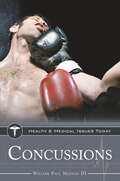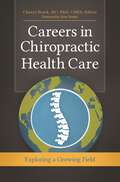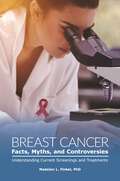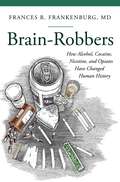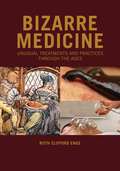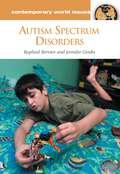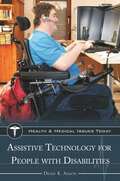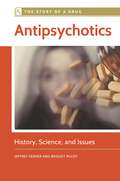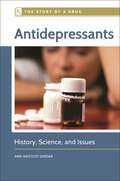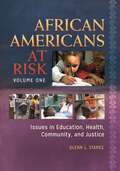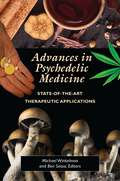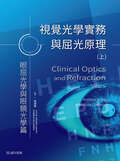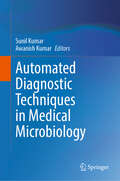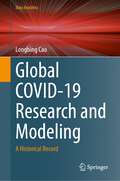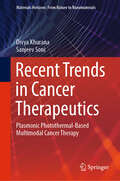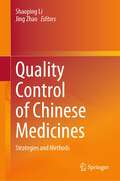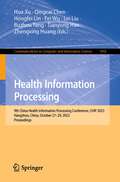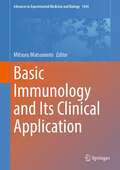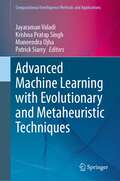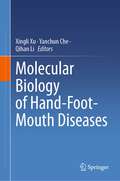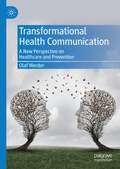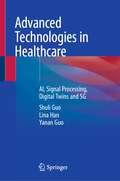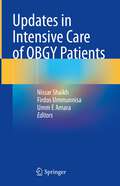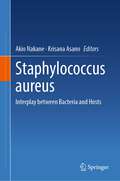- Table View
- List View
Concussions (Health and Medical Issues Today)
by William Paul IIIThis book provides a broad introduction to the important topic of concussive brain injury that considers historical, medical, research-based, and legal and ethical perspectives.The devastating long-term effects of concussions and the apparent mismanagement of concussion treatment among college and professional athletes have received major media attention in recent years. Do athletes—especially young ones—and their parents understand the physical risks and potential lifelong costs involved with playing their sport? Are injuries handled properly, or are players' careers and teams' successes put ahead of health and safety? Written by a Harvard-educated doctor who conducts clinical and scientific research in the area of sports injuries and concussive brain injuries, this book provides readers with honest and authoritative information about concussions. The book's chapters address the subject from all angles and shed light on current debates related to concussions caused by sports injuries and accidents.
Careers in Chiropractic Health Care: Exploring a Growing Field
by Cheryl Hawk and John WeeksThis book provides potential students of a chiropractic career path, as well as other health care practitioners, with vital information regarding the training required to enter the chiropractic field and the roles of chiropractors in modern health care.Chiropractic is the second largest physician-level health profession in the United States, with chiropractors providing care to at least 20 million patients annually. As chiropractic health care has been proven to be both effective and cost effective for many musculoskeletal conditions, particularly back pain, the inclusion of Doctors of Chiropractic (DCs) in a variety of health care settings is likely to continue to increase. Surprisingly, there is little readily accessible information on chiropractic as a career path. This book provides concise yet comprehensive information about career paths, training, and professional roles in chiropractic for students considering chiropractic as well as health care practitioners in the field.Written in an easy-to-read style, Careers in Chiropractic Health Care: Exploring a Growing Field serves students, those in non-chiropractic health fields, and general readers considering chiropractic as a career change option. The chapters explain the training and specific licensure requirements for chiropractors in all 50 U.S. states and provide information useful to health care professionals for referrals and management of patients using chiropractic care.
Breast Cancer Facts, Myths, and Controversies: Understanding Current Screenings and Treatments (Public Health Issues and Developments)
by Madelon L. FinkelThis book, written for the layperson, provides evidence-based material explaining the complex and evolving evidence of the benefits and limitations of breast cancer screening and the advances in breast cancer treatment.A diagnosis of breast cancer is one of the most emotionally charged statements a woman can hear from her doctor. Understanding the rapid changes in breast cancer diagnosis and treatment is challenging, especially for those without a medical background. This book will help explain the strengths and weaknesses of breast cancer screening, breast cancer treatment, and ways of coping with the disease (for oneself or a loved one).Written for the layperson, this text explains the history of disease prevention with a specific emphasis on breast cancer detection and treatment. The main chapters weigh the pros and cons of well-known but often mystifying screening tests, such as mammograms; discuss the benefits and side effects of targeted hormone therapies; consider holistic regimens that complement traditional medicine; and explore the mental, physical, and emotional strain caused by breast cancer. Concluding with the current breast cancer screening guidelines recommended by leading organizations in disease prevention, Breast Cancer Facts, Myths, and Controversies not only engages with the history of breast cancer screening, diagnosis, and treatment, it looks ahead to a brighter future for survivors.
Brain-Robbers: How Alcohol, Cocaine, Nicotine, and Opiates Have Changed Human History
by Frances R. MDA psychiatrist examines how the world's four most important mind-altering substances— alcohol, cocaine, nicotine, and opiates—have played a significant role throughout human history, and explains how these powerful drugs affect the brain and cause addiction.Alcohol, cocaine, nicotine, and opiates have spurred some of the greatest human pleasure and pain across time. Providing information that ranges as widely as from ancient Egypt to modern times, this book comprehensively addresses the good, the bad, and the very ugliest aspects of these substances, examining their history, their effects on the brain and body, and on civilization itself. Frances R. Frankenburg, MD, employs accessible, everyday language to explain the neurology of addiction and describe how these "brain-robbing" substances work to hijack the brain's pleasure systems to create powerful addictions. The author also provides perspective into the intertwined, inescapable, and often uneasy relationship between these substances and human culture, economics, and politics—for example, how individuals become physically or psychologically addicted to alcohol, cocaine, nicotine, and opiates, while governments become financially "addicted" to the revenue, such as taxes, that can be collected from the sale and use of these substances.
Bizarre Medicine: Unusual Treatments and Practices through the Ages
by Ruth Clifford EngsThis encyclopedia explores historical and contemporary fringe remedies seen as strange, ridiculous, or even gruesome by modern Western medicine but which nevertheless played an important role in the history of medicine.From placing leeches on the neck to treat a cough to using crocodile dung to prevent pregnancy, a number of medical treatments that now seem unusual were once commonplace. While a few of these remedies may have been effective, most were either useless or actually counterproductive to good health. Even today, there are alternative and fringe treatments considered bizarre by mainstream medicine yet used by hundreds of thousands of people.Bizarre Medicine: Unusual Treatments and Practices through the Ages offers a fascinating look into the history of medicine. Entries are organized by disease or medical condition and explore the folk and traditional "cures" used to treat them. Explanations are provided for why some treatments may have worked and why others may have done more harm than good. In addition, entries provide a clear description of the causes, symptoms, and current treatment options for each condition based on current scientific understanding. Each entry also discusses the condition's enduring impact on society and the arts.
Birth Control: Your Questions Answered (Q&A Health Guides)
by Paul QuinnThis book will serve as a scientifically accurate yet easy-to-read introduction to birth control for teens and young adults. The information, guidance, and resources it offers will help readers to make better decisions regarding their sexual health.From barrier methods such as condoms and diaphragms to oral contraceptive pills and from hormone-based implants and injectables to permanent sterilization techniques, there are a number of ways to prevent unwanted pregnancy today. But which are the most effective, and how do you choose the method that's right for you? What about side effects and long-term implications for health, such as increased risk for cancer? Does birth control affect your chances of getting pregnant in the future? Birth Control: Your Questions Answered, a part of Greenwood's Q&A Health Guides series, provides clear, concise answers to these and other questions young readers may have about this sometimes embarrassing, yet very important, topic. Each book in this series follows a reader-friendly question-and-answer format that anticipates readers' needs and concerns. Prevalent myths and misconceptions are identified and dispelled, and a collection of case studies illustrates key concepts and issues through relatable stories and insightful recommendations. The book also includes a section on health literacy, equipping teens and young adults with practical tools and strategies for finding, evaluating, and using credible sources of health information both on and off the internet—important skills that contribute to a lifetime of healthy decision-making.
Autism Spectrum Disorders: A Reference Handbook (Contemporary World Issues)
by Raphael Bernier Ph.D. Jennifer GerdtsThis handbook provides an overview of the current scientific understanding of autism spectrum disorders, as well as a cultural and historical perspective on the controversies that plague the field."Autism" describes a complex developmental disability that interferes with social interaction and communication. Symptoms of autism are generally recognizable when children are under the age of three. Until the 1990s, rates for autism were generally estimated at 1 in 2500. In 2010, however, the estimate is now 1 in 110 children. Is the incidence of autism increasing, or has there simply been a shift in how often this disability is diagnosed as the problem?This text provides a comprehensive explanation of autism spectrum disorders (ASD). Autism Spectrum Disorders: A Reference Handbook educates readers about ASD without relying on confusing medical jargon, highlighting current understanding of etiology, neuroscience, and intervention. It also discusses the historical and cultural influences of ASD and explores the controversial aspects of autism.
Assistive Technology for People with Disabilities (Health and Medical Issues Today)
by Denis K. AnsonHow would you make a phone call or send email if you couldn't hear, see, or use your hands? This book shows how assistive technology helps individuals with disabilities perform tasks that people without disabilities may take for granted.Assistive technology can be used in two ways: to help people with disabilities to do things that people without disabilities can do without technology, and to improve access to everyday technology that is not designed for people with disabilities. In both cases, the focus is on matching individuals with the tools best suited to fill their needs. A part of Greenwood's Health and Medical Issues Today series, Assistive Technology for People with Disabilities explores what technologies are available to individuals with disabilities, what they can help them to accomplish, and potential hurdles to their use that must be overcome. It explores this exciting field broadly and in depth while still keeping the "people-first" mindset that is the hallmark of assistive technology. In addition, it provides guidance and resources for individuals seeking assistive technology for themselves or for a loved one.
Antipsychotics: History, Science, and Issues (The Story of a Drug)
by Jeffrey Kerner Bridget McCoy M.D.The problem of serious mental illness is a widely discussed topic in the media and popular culture. This text provides a comprehensive analysis of antipsychotic medications, covering historical, social, and scientific viewpoints on this important and controversial class of medications.Antipsychotics are unique drugs with the ability to alter how people think and communicate. As a result, physicians must weigh a range of implications when prescribing antipsychotics. Antipsychotics: History, Science, and Issues offers a robust explanation of antipsychotic medications that covers the historical, ethical, medical, legal, and scientific dimensions of antipsychotics. The chapters explore topics ranging from the science of how examples of this class of drug actually work in the body to the social and legal implications of antipsychotics, making this subject understandable and relatable for lay readers who are not mental health practitioners. Readers will learn why prescribing antipsychotics is often a difficult decision due to the inherent risks of giving these medications to different types of patients and appreciate how mental health laws impact psychiatrists' prescribing practices.
Antidepressants: History, Science, and Issues (The Story of a Drug)
by Ann Westcot JordanThis accessible volume offers a holistic exploration of this diverse class of drugs, from medical, historical, cultural, and economic perspectives.Depression is one of the most commonly reported mental disorders, and it affects millions of Americans. A wide variety of medications are used to treat depression, many of which have become household names—Zoloft, Prozac, and Paxil among them. Because these medications have the ability to alter how people think and feel, however, physicians must weigh a number of factors when prescribing them, especially to teens. Antidepressants: History, Science, and Issues, a part of Greenwood's Story of a Drug series, offers a robust exploration of antidepressant medications that covers the historical, ethical, medical, legal, and scientific dimensions of these drugs.After an introductory case study of a person with depression and this individual's problems and successes with antidepressants, the book provides an overview of depression and its various symptoms as well as the causes, prevalence, and diagnosis of depression. Readers will gain an understanding of the neurotransmission and specific mechanisms behind the activity of antidepressant medications; the effects and applications of these drugs, plus their associated risks of misuse and abuse; and related policy and societal issues.
African Americans at Risk [2 volumes]: Issues in Education, Health, Community, and Justice [2 volumes]
by Glenn L. StarksWith all of the progress African Americans have made, they still face many risks that threaten the entire race or place segments in jeopardy of survival. This work examines the widespread problem and suggests solutions.This two-volume set examines the issues and policies that put African Americans at risk in our culture today, utilizing the most recent research from scholars in the field to provide not only objective, encyclopedic information, but also varying viewpoints to encourage critical thinking. The entries comprehensively document how African Americans are treated differently, have more negative outcomes in the same situations than other races, and face risks due to issues inherent in their past or current social and economic conditions. Care is taken to note distinctions between subgroups and not further a "blanket approach" to the diverse members of this minority population. Intended for members of the African American community; societal scholars; students in the fields of health, social studies, and public policy; as well as general readers, this work will provide readers with a deeper understanding of key components affecting the lives of African Americans today.
Advances in Psychedelic Medicine: State-of-the-Art Therapeutic Applications
by Michael Winkelman and Ben Sessa, EditorsResearchers, program administrators, and practicing clinicians explain the most recent developments in using psychedelic substances to treat psychological, physiological, and social problems.More than a decade ago, the U.S. government lifted its ban on all testing of psychedelic substances. Winkelman and Sessa now provide updated scientific research and applications of these substances, now moving into approved categories of medicine. The text is an up-to-date assessment of the latest advances in the field of psychedelic medicine, covering the use of LSD, psilocybin, MDMA, ayahuasca, and other substances to augment psychotherapies for a range of disorders. It discusses medical and psychiatric concerns, clinical efficacy and safety, ethical considerations, and neuroscience findings regarding the psychedelic compounds. Topics covered include an overview of psychiatric applications of psychedelics; treatments for addictions and depressive disorders; effects of psychedelics on inflammation and neuroplasticity; evidence for clinical applications of DMT, ayahuasca, and cannabidiol; psychedelic treatment of sociopathic disorders; microdosing psychedelics; training psychedelic therapists; and community-based harm reduction approaches to managing psychedelic crises.
Clinical Optics and Refraction
by Andrew Keirl, Caroline Christie, 路建華It provides a comprehensive and clinically based guide to visual optics. With its suggested routines and numerous examples, this new book offers a straightforward "how to approach" to the understanding of clinical optics, refraction and contact lens optics. Designed for easy access, it presents information in a concise format that highlights key, need-to-know points. Part 1 addresses the basic visual optics of the eye along with emmetropia, ametropia and the correction of ametropia with spectacle lenses. Part 2 turns to the optics of contact lenses and the use of contact lenses in vision correction.Numerous worked examples based on real examination questionsPractical and user friendly textOver 190 clear line diagramsAn essential passport to examination success and a valuable quick reference for practitioners
Automated Diagnostic Techniques in Medical Microbiology
by Sunil Kumar Awanish KumarThis book will explore the knowledge of current diagnostic automation techniques applied in the field of clinical microbiology, tropical diseases, POCT, etc. There is no such type of book related to this topic. This book will help clinicians, microbiologists, and researchers to make diagnostic algorithms for infectious diseases and help them in early diagnosis. Automation in clinical microbiology has revolutionized routine practice in diagnostic cum research in medical microbiology. This book covers the recent updates and advances in diagnostic microbiology and provides new techniques related to Genomic, Proteomic, and metabolomics in microbiology. This book will intensely discuss the new and innovative automation techniques available for diagnosis in the microbiology laboratory. This book is more focused on automation techniques, which are used in the early detection of infectious diseases even caused by rare microorganisms. Furthermore, this book has complied with the chapters that provide insights to readers with comprehensive and usable knowledge on automation techniques in diagnostic microbiology.
Global COVID-19 Research and Modeling: A Historical Record (Data Analytics)
by Longbing CaoThis book provides answers to fundamental and challenging questions regarding the global response to COVID-19. It creates a historical record of COVID-19 research conducted over the four years of the pandemic, with a focus on how researchers have responded, quantified, and modeled COVID-19 problems. Since mid-2021, we have diligently monitored and analyzed global scientific efforts in tackling COVID-19. Our comprehensive global endeavor involves collecting, processing, analyzing, and discovering COVID-19 related scientific literature in English since January 2020. This provides insights into how scientists across disciplines and almost every country and regions have fought against COVID-19. Additionally, we explore the quantification of COVID-19 problems and impacts through mathematics, AI, machine learning, data science, epidemiology, and domain knowledge. The book reports findings on publication quantities, impacts, collaborations, and correlations with the economy and infectionsglobally, regionally, and country-wide. These results represent the first and only holistic and systematic studies aimed at scientifically understanding, quantifying, and containing the pandemic. We hope this comprehensive analysis will contribute to better preparedness, response, and management of future emergencies and inspire further research in infectious diseases. The book also serves as a valuable resource for research policy, funding management authorities, researchers, policy makers, and funding bodies involved in infectious disease management, public health, and emergency resilience.
Recent Trends in Cancer Therapeutics: Plasmonic Photothermal-Based Multimodal Cancer Therapy (Materials Horizons: From Nature to Nanomaterials)
by Divya Khurana Sanjeev SoniThis book describes the plasmonic photothermal-assisted multimodal cancer therapeutics in the area of cancer nanotechnology or cancer nanomedicine. This book covers the fundamentals of plasmonic photothermal cancer therapy as well as plasmonic photothermal mediated multimodal cancer therapy. The various steps involved in developing such therapeutic modality, viz. (a) the selection of suitable nanoparticles, (b) synthesis of multifunctional nanocomposite, (c) optimization of the photosensitizer and chemotherapeutic drug loadings, (d) characterization of the synthesized nanocomposite, and (e) therapeutic evaluations through novel tumor-tissue mimicking phantoms and the cancer cell lines are discussed in detail. Apart from the detailed description of therapeutic outcome, this book provides a step-by-step approach to develop a multifunctional nanocomposite for such therapeutics. Overall, this book provides simplified and in-depth information about cancer nanobiotechnology to the researchers and graduate students in subject areas of nanotechnology, biotechnology and pharmaceutics to develop and contribute to such multimodal cancer therapeutics.
Quality Control of Chinese Medicines: Strategies and Methods
by Jing Zhao Shaoping LiThis book focuses on the strategies and methods for quality control of Chinese medicines used in prevention and treatment of diseases for thousands of years in China and East Asia. It explains various strategies and methods for quality markers discovery and herbal glycoanalysis, as well as practices for control of heavy metal and pesticide residues. Strategies to overcome the shortage of reference compounds for quality control of Chinese medicines are also provided. The book also introduces analytical techniques for different analytes in Chinese medicines with an emphasis on sample preparation in automation and high extraction efficiency methods, the key process affecting the time and accuracy of the techniques. It is of interest to quality control scientists in academia and industry working on Chinese medicines and/or herbal medicine and also pharmacists, pharmacologists, food chemists, and nutritionists who want to understand Chinese medicines.
Health Information Processing: 8th China Conference, Chip 2022, Hangzhou, China, October 21-23, 2022, Revised Selected Papers (Communications In Computer And Information Science Ser. #1773)
by Hua Xu Qingcai Chen Hongfei Lin Fei Wu Lei Liu Buzhou Tang Tianyong Hao Zhengxing HuangBasic Immunology and Its Clinical Application (Advances in Experimental Medicine and Biology #1444)
by Mitsuru MatsumotoThis book overviews ongoing and upcoming clinical applications of basic immunology. Recent advances in our knowledge of immunology coupled with new technologies have aided in the development of efficient cancer immunotherapy, as well as the control of emerging microorganisms such as SARS-CoV-2. However, knowledge of basic immunology has not been fully utilized even after the discoveries of immune checkpoint inhibition for cancer immunotherapy and the development of mRNA vaccination against SARS-CoV-2. There is still room for improving the clinical application of basic immunology. The book summarizes the achievements in clinical applications of basic immunology and highlights what can be further extended to make immunology a more practical human science. Basic immunology and its clinical applications are two wheels of the same cart in the immunology field, which aids in the development of more efficient cancer immunotherapy and rapid control of infectious diseases against microorganisms, including new viruses and classical toxoplasmosis. The exploration of ongoing and upcoming applications of basic immunology in this book makes it a useful resource for immunologists, physicians, molecular and genome biologists, bioinformaticians, and students in these fields.
Advanced Machine Learning with Evolutionary and Metaheuristic Techniques (Computational Intelligence Methods and Applications)
by Jayaraman Valadi Krishna Pratap Singh Muneendra Ojha Patrick SiarryThis book delves into practical implementation of evolutionary and metaheuristic algorithms to advance the capacity of machine learning. The readers can gain insight into the capabilities of data-driven evolutionary optimization in materials mechanics, and optimize your learning algorithms for maximum efficiency. Or unlock the strategies behind hyperparameter optimization to enhance your transfer learning algorithms, yielding remarkable outcomes. Or embark on an illuminating journey through evolutionary techniques designed for constructing deep-learning frameworks. The book also introduces an intelligent RPL attack detection system tailored for IoT networks. Explore a promising avenue of optimization by fusing Particle Swarm Optimization with Reinforcement Learning. It uncovers the indispensable role of metaheuristics in supervised machine learning algorithms. Ultimately, this book bridges the realms of evolutionary dynamic optimization andmachine learning, paving the way for pioneering innovations in the field.
Molecular Biology of Hand-Foot-Mouth Diseases
by Xingli Xu Yanchun Che Qihan LiThis book aims to compile the latest scientific information on hand, foot, and mouth disease (HFMD), including its epidemiology, etiology, pathology, immune response and vaccine development. Interestingly, the authors shared their own research experience and offered distinctive insights into the pathogenesis of HFMD and vaccine development. The intended audience, including university researchers, graduate students, and vaccine engineers, is well defined. The book is positioned as a resource that not only presents current knowledge but also has the potential to inspire further research in understanding immune pathogenesis and advancing vaccine development for HFMD.
Transformational Health Communication: A New Perspective on Healthcare and Prevention
by Olaf WerderThis book advances our understanding of communicative relationships and key barriers to more effective health communication. In this, it offers a humanistic orientation of health communication as well as its social, cultural, political, ethical, and spiritual dimensions and contexts. The book therefore brings a more inclusive and integrated approach to the major challenges and opportunities in contemporary health, medicine, and wellbeing.
Advanced Technologies in Healthcare: AI, Signal Processing, Digital Twins and 5G
by Shuli Guo Lina Han Yanan GuoThis book explores the applications of cutting-edge technologies such as AI, blockchain, signal processing, digital twin technology, and 5G communication technology in healthcare. The writing style combines diagrams, tables, formulae, and text to enhance readability. The content combines theoretical analysis and medical application in every chapter. This book presents several innovative methods, including an AI-based computer-aided diagnosis system, a blockchain-based AI system framework for healthcare, pre-processing algorithms for medical imaging, digital twin models for healthcare, a healthcare platform based on cloud, fog, and edge computing, and a personal health device domain information model. This book will be valuable for researchers, engineers, and post-graduate students in the fields of medicine management and software engineering.
Updates in Intensive Care of OBGY Patients
by Nissar Shaikh Firdos Ummunnisa Umm E AmaraThis book presents the updated management of acute and critically ill obstetric and gynecological patients. It describes patients' care with pregnancy-induced medical disorders, comorbidities, and gynecological (OBGY) conditions requiring acute and intensive care support therapy. This book will guide early diagnosis and speedy management of life-threatening conditions. Chapters provide a comprehensive and systemic approach in an easy-to-understand format. Along with diseases and comorbidities of pregnancy, acute illness and its management caused by in vitro fertilization (IVF) are focused on, and a dedicated chapter about COVID-19 infection in obstetric patients is provided.Updates in Intensive Care of OBGY Patients will support intensivists, obstetricians, gynecologists, acute care physicians, and surgeons. Residents, fellows, specialists, and other junior medical staff working in intensive care units will also value this source. It will also help to broaden the understanding of nurses and paramedical staff in intensive care therapy.
Staphylococcus aureus: Interplay between Bacteria and Hosts
by Akio Nakane Krisana AsanoStaphylococcus aureus is an opportunistic human pathogen that colonizes the mucosal surfaces. It is the causative agent of various serious acute and chronic infections. Recent prevalence of infectious diseases caused and expanded by hospital-acquired methicillin-resistant S. aureus (HA-MRSA), community-acquired methicillin-resistant S. aureus (CA-MRSA) and livestock-acquired methicillin-resistant S. aureus (LA-MRSA). MRSA infections must be more serious problem in near future. It is presumed that offense and defense responses are continuously executed between S. aureus and host to establish and maintain commensalism for S. aureus. Therefore, it is essential to elucidate interplay between S. aureus and hosts to prevent staphylococcal infectious diseases. This book is comprised of content that focuses on this aspect.
